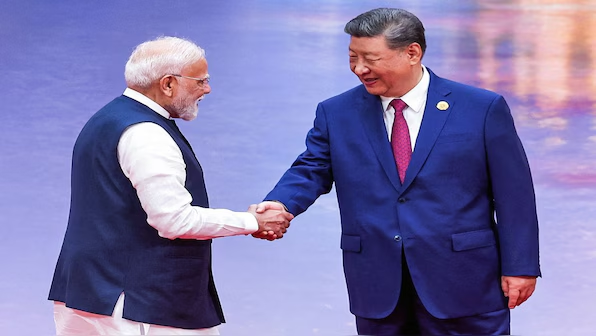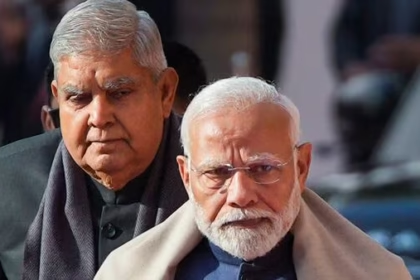China India Relations Strengthen with Rapprochement Beyond US Pressure
Five years ago, Sino-Indian relations were going through one of their worst crises since the 1962 war, following hand-to-hand combat between Chinese and Indian soldiers that left 20 of the latter dead in the Galwan Valley in June 2020. The Indian government subjected all foreign investment from neighbouring countries to an ad hoc procedure (which was in fact aimed at China), drastically reduced the granting of visas to Chinese visitors and banned nearly 60 Chinese apps and websites. Negotiations between the two armies, through which India hoped to recover at least part of the territories conquered by the Chinese, dragged on without result.
Five years later, Narendra Modi visited China – something he had not done since 2018 – for a SCO meeting during which Modi told Xi Jinping that India was “committed” to taking their countries’ relations forward “on the basis of mutual trust and respect,” and referenced their improving ties, including an easing of tensions along their disputed Himalayan border.
India’s attitude has been interpreted in various ways. Some analysts have attributed it to Donald Trump’s policy. Trump decided to impose record tariffs (50% on US imports from India), which China has publicly denounced. Others saw it as an expression of India’s famous strategic autonomy, which consists, in a logic inherited from non-alignment – since renamed “plurilateralism” – of maintaining relations with as many partners as possible without ever taking sides (at least not to the point of becoming an ally).
These interpretations – which of course contain some truth – seem to me to overlook an essential factor, namely India’s dependence on China, which today leads it to submit to Chinese domination – even if it means sacrificing part of its strategic autonomy – rather than playing Beijing off against Washington.
The art of swallowing bitter pills
The ongoing normalisation of Sino-Indian relations is taking place at a time when, in geostrategic terms, India has not achieved its objectives. Despite 17 rounds of discussions between representatives of the Indian army and the PLA, the Chinese have done little more than concede to the Indians that they can once again patrol – with them – in the Demchok and Depsang sectors, while informed observers relying on satellite images maintain that the PLA still occupies 2,000 square kilometres of Indian territory, including in the Galwan Valley.
However, in October 2024, the Indian Ministry of External Affairs announced that India and China had reached an agreement that allowed Indians, in Jaishankar’s words, to “patrol as we had been doing until 2020” – and the minister concluded: “With that, we can say that the disengagement with China has been completed.”
He was contradicted the very next day by the army chief, General Upendra Dwivedi, who said that the disengagement would only be complete once the situation prior to the 2020 fighting had been restored. Many experts – based on information from the field and satellite images – considered at the time that a return to the status quo ante was not imminent and that New Delhi was claiming the opposite in order to pretend that relations between India and China were on the way to normalisation.
There was a certain urgency to confirm that this was the case, given that Narendra Modi was due to meet Xi Jinping in Kazan for the BRICS Summit a few days later and clearly wanted to bury the hatchet. We will return to his motives in the second part of this article.
A similar scenario unfolded during the hostilities between India and Pakistan last May. When the terrorist attack on April 22, which claimed the lives of 26 civilians in Pahalgam (Jammu and Kashmir), was attributed by New Delhi to Pakistani terrorist groups and the likelihood of Indian retaliation increased, Wang Yi, the Chinese Minister of Foreign Affairs, stated: “As an ironclad friend and an all-weather strategic cooperative partner, China fully understands Pakistan’s legitimate security concerns and supports Pakistan in safeguarding its sovereignty and security interests” .
Never before, during a conflict between India and Pakistan, had Beijing taken the latter’s side in this way. Echoing Islamabad, Wang Yi even asked the Indians to agree to a “swift and fair investigation” to identify those responsible for the attack, which amounted to casting doubt on Pakistan’s involvement.
During the conflict, according to Indian sources, China assisted Pakistan with air defence by providing satellite imagery. The Deputy Chief of Army Staff (Capability Development & Sustenance), Lt Gen. Rahul R. Singh, confirmed that Pakistan “was getting live inputs from China” during the fighting. As for the weapons used by the Pakistanis, they were mainly Chinese, as is 80% of the country’s arsenal. Three of them played an important role: the PL-15 missile with a range of 200 km, which reportedly enabled the Pakistanis to destroy an IAF Rafale, the J-10 C fighter jet (which carried this missile) and the HQ-9 air defence system.
Goodwill and desire for normalisation
After the guns fell silent, when India – which had just denounced the Indus Treaty – announced that it could deprive Pakistan of part of the water to which it was entitled under the treaty, China hinted that it too could deprive India of water from the Brahmaputra. Shortly before, as soon as military operations had ended, Pakistani foreign minister Ishaq Dar travelled to Beijing to meet with his counterpart.
India – whose external affairs minister, Jaishankar, had declared on April 10 that relations between India and China “were much better than before” – did not issue any protest against China either during or after the hostilities.
It was in this context that Jaishankar travelled to Beijing in July 2025 to meet with Chinese Vice President Han Zheng. Upon his arrival, he took to social media to praise “the improvement in our bilateral ties. And expressed confidence that discussions during my visit will maintain that positive trajectory”.
How can this goodwill and desire for normalisation be explained? Admittedly, the imbalance of military forces is now very great. India can hardly compete with China on the anti-missile front – which has become decisive in modern warfare – since it only has two S-400 batteries (and is expected to receive three more in the short term), while China has half a dozen, plus three HQ-9s, the equivalent of S-300s or even S-400s .
At sea, the contrast between India and China is even more pronounced, with the latter having invested even more in this area to build a Blue Navy. While India has only 16 submarines (including two nuclear-powered ones), China has 65, including 12 nuclear-powered ones.
In the air, China’s superiority is ensured by the number of aircraft that can take off from aircraft carriers, 60 to 70 J-15s compared to 45 MiG-29Ks, and by the number of Multi-Role Combat Aircrafts, 4th or 5th generation, because while India has 36 Rafales, China has 200 J-20s.
But if this imbalance can justify India’s low profile vis-à-vis China, why is it so keen to normalise relations, an attitude that dates back to last year?
Increased economic dependence
Some Indian officials began advocating a change in policy towards China even as the New Delhi government criticised the slow pace at which the People’s Liberation Army was negotiating its withdrawal with the Indian General Staff and tensions remained high in the Himalayas. Signs of economic openness began to emerge in the first half of 2024. In July 2024, the annual release of the Economic Survey sparked intense debate. The survey “argues that FDI inflows ‘from China can help in increasing India’s global supply chain participation along with a push to exports’.
Second, it says that relying on Chinese FDI ‘seems more promising for boosting India’s exports to the US, similar to how East Asian economies did in the past’. Finally, the Survey opines that ‘as the US and Europe shift their immediate sourcing away from China, it is more effective to have Chinese companies invest in India and then export the products to these markets, rather than importing from China, adding minimal value, and then re-exporting them’”.
Although the Modi government’s chief economic advisor, V. Anantha Nageswaran, was behind these recommendations, he could not have done so without the agreement of Union finance minister Nirmala Sitharaman, who had publicly expressed concern about the decline in foreign investment in India. Following a downward trend (more than linear), the share of FDI in India, after peaking at 3.50% of GDP in 2008-09, fell to 1.25% in 2022-23. This is because, as Alicia Garcia-Herrero, chief Asia Pacific economist at Natixis, explained: “The US and Europe are a little hesitant to invest in India’s manufacturing sector, with most foreign investment going to the ICT [Information and Communication Technologies] sector, such as digital services,” .
The low level of foreign investment in India has sounded the death knell for the “Make in India” programme, which was launched with great fanfare by Narendra Modi the day after he came to power. However, strengthening Indian industry is an absolute priority in order to create the jobs that young people so desperately need. Youth unemployment is a major challenge for Narendra Modi.
The 2024 Economic Survey opened up a dual perspective that could circumvent the reservations of BJP leaders – including Piyush Goyal, the Minister of Commerce – who are nervous about an influx of Chinese investment: “To boost Indian manufacturing and plug India into the global supply chain, it is inevitable that India plugs itself into China’s supply chain. Whether we do so by relying solely on imports or partially through Chinese investments is a choice that India has to make (emphasis added).”
The preferred route was initially through trade, which was Goyal’s preference. But this policy also favoured FDI: by reducing customs duties on imports of lithium, nickel, cobalt and vanadium to zero, India invited Chinese battery manufacturers, one of the areas where India lags far behind, to forge links with Indian partners to produce them in the country. The reduction in customs duties on mobile phone components from 20% to 15% was interpreted in the same way.
In response, Chinese diplomats changed their tone. The Chinese ambassador to India has been sending out increasing signs of openness since the summer of 2024. He has expressed his support for increased Indian investment in China and a revival of scientific and technological cooperation between the two countries – while hoping that “the Indian side will be able to provide a healthy business environment for Chinese companies in India”.
Finally, in spring 2025, India reversed the policy it had put in place in 2020 and announced that Chinese investment projects, which were therefore welcome, would now be examined more quickly by the inter-ministerial committee responsible for the dossier.
India’s goodwill towards China in terms of its openness to Chinese FDI – and, more recently, on the diplomatic front – largely reflects its industrial dependence on China.
The Indian economy is increasingly dependent on Chinese imports.
In 2024, with $118 billion in trade in goods, China regained its position as India’s largest trading partner, supplanting the United States, which had overtaken it shortly before, for two fiscal years. At the same time, India’s trade deficit with China has widened steadily, jumping from $46 billion in 2019-20 to $85 billion in 2023-24 and $99.2 billion in 2024-25.
Indian exports – worth just $15 billion in 2024-25, less than in 2018-19 – consist mainly of raw materials (including iron ore) and refined oil , while Chinese exports to India, worth more than $124 billion (compared to $70.3 billion in 2019), consist mainly of manufactured goods, including machine tools, computers, organic chemicals, integrated circuits and plastics. The Indian industry is suffering even more from competition from China because it lacks competitiveness.
While Indian imports from China grew 2.3 times faster than Indian imports in general between 2005-06 (when India still had a trade surplus with China) and 2023-24, the share of industrial goods imported by India from China rose from 21% to 30% of India’s total industrial imports over the period.
The composition of Indian imports from China is very revealing here: finished products account for only 6.8% of India’s total imports of industrial products from China, while intermediate goods and capital goods account for 70.9% and 22.3% respectively in 2023-24.
Indian industry needs these Chinese goods to ensure its own production, whether they are electronic, electrical or automotive spare parts, active ingredients for drug and vaccine manufacturers, or computers (which are classified as capital goods when used for professional purposes). This situation explains why the more India exports, the more it also imports in order to have the components it needs to assemble the smartphones, cars and medicines it sells to the rest of the world – mainly to the West.
Electronics is a textbook case here, especially since Foxconn opened its Sunguvarchatram factory in the heart of the industrial corridor between Chennai and Bengaluru with great fanfare. Smartphones now account for half of India’s exports of manufactured electronic products, with iPhones accounting for 70% of this total. However, a very large proportion of the components used in the manufacture of smartphones are imported from China, due to a lack of sufficiently efficient local suppliers – this proportion is 95% for premium iPhones. 70% of the electronic components imported by India come from China.
At £32.15 billion, imports of electronic products and electrical equipment were India’s largest purchase from China in 2023. In 2021, laptops imported from China alone accounted for $4.35 billion and when, in August 2023, the Indian government attempted “to institute licensing controls on the import of laptops and personal computing devices in the hope of stemming the influx of Chinese technology, a swift backlash from Indian industry groups forced it to scrap its plans”.
A similar argument applies to the pharmaceutical sector. India has become “the world’s pharmacy” thanks to its sales of generic drugs – 60,000 in total – a highly extroverted sector: of its £42 billion in turnover, £25 billion came from exports. Today, 40% of generic drugs sold in the United States are imported from India, for example, which will pose a major problem for the sector if US customs duties rise to 50%. However, two-thirds of the active ingredients used by the Indian pharmaceutical industry came from China in 2019, for a total amount of $2.4 billion – those from elsewhere cost India $1.6 billion.
In 2023, an in-depth study published by Bloomberg showed that Aurobindo Pharma, India’s leading exporter of generic drugs – in terms of volume – to the United States, sourced 55% of the active ingredients and other components used in its medicines from China (from which Washington had hoped to become independent by importing more from India).
The Chinese seem determined to exploit this position of strength. Last spring, while India was already showing goodwill towards China, the latter took advantage of the way the United States was putting India on the defensive to toughen its stance by making it more difficult for Indian manufacturers to access some of the products they imported from China. As a result, car manufacturers were subjected to very cumbersome bureaucratic procedures for purchasing the rare earths they needed for their electric vehicles. Similarly, China suspended sales of specialised fertilisers on which Indian fruit and vegetable producers in particular depend for 80% of their supply, by introducing new and highly opaque procedures.
It was against this backdrop that Jaishankar visited Beijing on July 14 and Wang Yi visited New Delhi on August 18, a frequency that marks the intensification of exchanges between the two countries. In August, even more so than in July, these exchanges were marked by normalisation, with both countries agreeing to “facilitate trade and investment flows between the two countries through concrete measures”. Alongside symbolic advances – such as the reopening of Mount Kailash and Lake Manasarovar to Hindu pilgrims – other more substantial advances were recorded, such as the commitment by both parties to facilitate the granting of visas and the restoration of direct flights between the two countries.
In addition to these points included in the final communiqué, the Chinese media deduced from the exchanges between the two parties that, for India, Taiwan is now part of China, which the Indian authorities have not denied, which may appear to be a sign of weakness on the part of a country that has been trying not to use the “One China” formula for nearly two decades.
Following Wang Yi’s visit, Indian farmers regained access to the Chinese fertilisers they urgently needed and Chinese deliveries of rare earths to India resumed.
It should be noted that India was not concerned by the fact that Wang Yi, after his visit to India, travelled to Kabul and Islamabad, even though the prospect of such a “group trip” had sparked vehement protests from New Delhi when the Indonesian President had considered it in January 2025 (and had subsequently abandoned the idea).
However, Wang Yi’s visit to Pakistan not only lasted three days, but also provided an opportunity to hold a meeting, “The Sixth Pakistan-China Foreign Ministers’ Strategic Dialogue”. As for the Afghan leg of the trip, it allowed Wang Yi, Ishaq Dar and their Afghan counterpart to co-chair “The Sixth Trilateral Foreign Ministers Dialogue” to declare their support for extending the China–Pakistan Economic Corridor (CPEC) to Afghanistan.
India is thus seeing China establish itself in another neighbouring country, even though it has long sought to forge ties with Afghanistan since the return of the Taliban.
The rapprochement we are witnessing between India and China is now possible because India has resigned itself to seeing China encroach on its territory in the Himalayas and come to the aid of its public enemy number one, Pakistan.
This may be seen as only a modest shift, given that New Delhi has already been collaborating with Beijing for years within the BRICS, a coalition aimed at challenging Western dominance on the international stage. Some will therefore see a real continuity between this anti-Western tradition and the current Sino-Indian convergence, at a time when the entire Global South (of which these two countries – like Russia, another pillar of the BRICS, claim to be the leaders) is mobilising against Donald Trump’s protectionist diktat.
This does not prevent the beginning of a real break, as India has never so easily resigned itself to Chinese domination. This resignation risks becoming a structural feature of the international scene, as it can be explained both by the military superiority of the Middle Kingdom and India’s dependence on it, a fact with serious geopolitical consequences, as Pant and Mankikar point out:
Giving leeway to China in the economic realm will have several other costs: it tarnishes India’s image as a rising power that can withstand Chinese coercion, undercuts the notion that India can serve as a bulwark against Beijing’s expansionism, and threatens initiatives that include India in the task of rebuilding supply chains outside China. And India’s forgiving economic policy toward China may encourage smaller regional countries such as Bhutan, which is a strategic buffer between the two powers, to seek accommodation with China – to India’s inevitable detriment.
One indicator of India’s resilience in the face of China – to be scrutinised in the future – will be the vehemence of its protests regarding China’s presence in its neighbourhood. In addition to Bhutan – and Afghanistan – Bangladesh – which India has alienated by supporting Sheikh Hasina – Nepal and Sri Lanka are likely to enter China’s orbit. If New Delhi does not react to this kind of development, it will be on the verge of experiencing the same development itself.
In this context, Western countries, which have developed the Indian component of their Indo-Pacific policy, often perceiving India as a counterweight to China, can help it preserve its strategic autonomy. The US administration can still change course and the EU can move in this direction by facilitating the conclusion of a substantial free trade agreement with India. The future will tell how far India can play the plurilateralism card here.
Also Read: Manipur Peace Pact Signed Between Centre and Kuki Zo Groups







